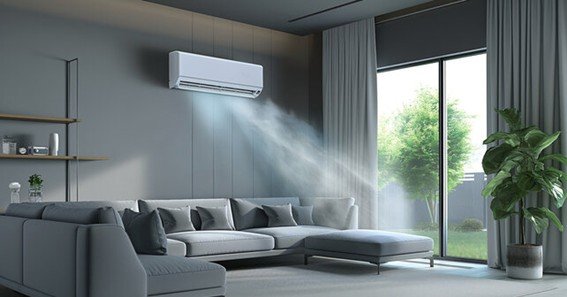If you’re on the lookout for a ductless ac window unit, you’ve come to the right place. These systems have been gaining popularity thanks to their flexibility, energy efficiency, and minimal installation requirements. Whether you’re upgrading your home’s HVAC setup or simply looking to cool a specific room, a ductless AC window unit can provide effective temperature control without the complexity of traditional central systems. In this blog, we’ll delve into how ductless AC window units work, the benefits they offer, and how to choose the right unit for your needs.
1. What Is a Ductless AC Window Unit?
A ductless AC window unit is essentially a self-contained air conditioning system designed to fit into a window opening without the need for extensive ductwork. It combines the condenser, evaporator, and refrigerant lines in a compact form. This design makes the unit easy to install and maintain compared to other, more complex cooling systems.
2. Key Benefits
-
Easy Installation: Unlike central air systems that require ductwork, a ductless window unit can be installed in a matter of hours. This makes it particularly appealing for older homes or rentals where installing ducts is impractical or not allowed.
-
Energy Efficiency: Many ductless units feature inverter technology that adjusts the cooling output based on room conditions. By delivering only the cooling needed, these systems often use less electricity and help lower energy bills.
-
Zoned Cooling: With a ductless AC window unit, you can cool a single room or area without having to turn on the air conditioning for the entire house. This approach can further reduce energy consumption.
-
Compact Design: Its relatively small footprint makes it a great choice for spaces where a portable AC might be too bulky or a central system is unfeasible.
-
Cost-Effective: While initial purchase costs vary, many ductless systems prove more affordable in the long run due to lower installation charges and reduced energy consumption.
Choosing the Right Ductless AC Window Unit for Your Space
Before buying a ductless AC window unit, consider the following factors to ensure you select the optimal model for your home or office:
-
Room Size: Calculate the BTU (British Thermal Unit) requirement based on the room’s square footage. A unit that’s too powerful or too weak can lead to inefficiency or inadequate cooling.
-
Energy Star Certification: Look for units with Energy Star ratings if you want to maximize efficiency and potentially qualify for utility rebates.
-
Noise Level: Different models produce varying levels of noise. Check decibel ratings if you’re concerned about quiet operation—especially in bedrooms or workspaces.
-
Installation Requirements: Ensure you measure your window dimensions accurately. Some units need a specific size range or type of window to fit securely.
-
Additional Features: Consider features such as remote controls, timers, and smartphone connectivity for better convenience.
3. Installation Tips
-
Check Window Type and Dimensions: Ensure your window can support the AC unit’s weight and that it can properly accommodate the unit’s width and height.
-
Secure Mounting: Most ductless AC window units come with a mounting kit. Follow the manufacturer’s guidelines closely for a secure fit and to prevent air leaks.
-
Seal the Gaps: Use foam or weatherstripping to seal any gaps around the unit. Proper sealing prevents heat from entering and cold air from escaping, improving efficiency.
-
Consider a Professional: While many units are marketed as DIY-friendly, hiring a technician ensures correct installation, prolonging your AC’s lifespan and maintaining its warranty.
4. Maintenance and Care
-
Regular Cleaning: Dust the filters and coils to maintain airflow. Clogged filters force the unit to work harder, increasing energy consumption.
-
Seasonal Checkups: Schedule periodic checkups at the start of the cooling season. A technician can spot early signs of wear or leaks.
-
Monitor for Noises or Odors: Unusual sounds or smells can signal mechanical or electrical issues that need immediate attention.
-
Proper Storage: If you remove the unit during the off-season, store it in a cool, dry place. Cover it to protect from dust and moisture.
Frequently Asked Questions
-
Is a ductless AC window unit the same as a mini-split?
Not exactly. While both are ductless systems, mini-splits typically have an outdoor condenser and an indoor air handler connected by refrigerant lines, whereas a ductless window unit houses most components in a single enclosure. -
How do I determine the right BTU rating for my room?
Generally, you need about 20 BTU per square foot of living space. However, factors like ceiling height, insulation, and sun exposure can alter the required capacity. -
Do ductless AC window units require professional installation?
Many units are designed for DIY installation, but if you’re unsure of the process or need to handle electrical connections, it’s wise to consult a licensed HVAC technician. -
Can a ductless AC window unit also provide heating?
Some models come with heat pumps that offer both cooling and heating capabilities. Always check the product specifications for dual-function features. -
Is a ductless AC window unit suitable for large rooms?
Most window units are best for medium or smaller spaces. For large or multiple rooms, a mini-split or central HVAC system may be more effective.Stay tuned to learn more about 1134-w-yale-fresno-ca










